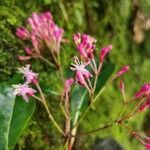Evergreen shrub or small tree to 8 m. high, normally glabrous.. Leaves opposite or in threes, elliptic to oblong-oblanceolate, mostly about 5–15 cm. long, and 2–5 cm. wide, acute or acuminate at both ends.. Flowers red-purple, in erect corymbose many-flowered panicles.. Hypanthium (see generic description) 3–8 mm. long, 1–3 mm. wide at top.. Sepals linear to lanceolate, up to 9 mm. long and 2.5 mm. wide.. Petals shorter than sepals.. Berry subglobose, up to about 10 mm. thick, purplish (fide Munz, l.c.).
An erect shrub or small tree. The crown is dense and round. It grows 2-8 m tall. The trunk is short and thick.

